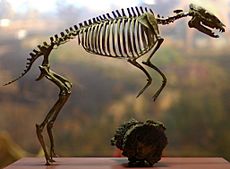Eohippus facts for kids
Quick facts for kids EohippusTemporal range: early Eocene
|
|
|---|---|
 |
|
| National Museum of Natural History, Washington, D.C. | |
| Scientific classification | |
| Kingdom: | |
| Class: | |
| Order: | |
| Family: | |
| Genus: |
†Eohippus
(Marsh, 1876)
|
Eohippus was a very small, ancient animal that looked a bit like a tiny horse. It is an extinct type of ungulate, which means it was a hoofed mammal. Scientists believe Eohippus is one of the earliest ancestors of today's horses. Its only known species is E. angustidens.
Fossils of Eohippus have been found in North America. These fossils show that it lived during the early Eocene epoch, which was about 48 to 56 million years ago. This makes Eohippus a very old part of the horse family tree!
Contents
Meet Eohippus: An Ancient Horse Ancestor

Eohippus means "dawn horse," and it's a perfect name for this animal. It was about the size of a small dog, standing only about 20 to 35 centimeters (8 to 14 inches) tall at the shoulder. Imagine a tiny animal, much smaller than any horse you see today!
Unlike modern horses, Eohippus had several toes on each foot. It had four toes on its front feet and three toes on its back feet. Each toe ended in a small hoof-like pad. This was very different from modern horses, which have only one toe (the hoof) on each foot. Over millions of years, horse ancestors slowly lost their extra toes, and their middle toe grew larger and stronger, eventually becoming the single hoof we know today.
What Did Eohippus Look Like?
Eohippus likely had a short, stocky body and a relatively short neck. Its teeth were designed for eating soft leaves and fruits, not tough grasses like modern horses. This tells us that Eohippus lived in forests and woodlands, where it could find plenty of leafy plants to munch on.
Scientists learn a lot about ancient animals like Eohippus by studying their fossils. These fossils help us understand how animals have changed over millions of years. They show us how different features, like toes and teeth, evolved to help animals survive in their changing environments.
Where Did Eohippus Live?
The story of the horse family, called Equidae, largely began in North America. This is where Eohippus lived, and where many other horse ancestors evolved over millions of years. For a long time, horses thrived in North America.
However, about 10,000 years ago, horses became extinct in North America. No one is entirely sure why this happened, but it might have been due to climate change or the arrival of early humans. Later, horses were brought back to North America by European explorers.
The Horse Family Tree
Eohippus is a very important part of the horse family tree. It helps scientists understand how horses evolved from small, multi-toed forest dwellers into the large, single-hoofed, grass-eating animals we see today. The changes in their feet, teeth, and size show how they adapted to different environments, especially as forests gave way to open grasslands.
Studying Eohippus and other early horse ancestors helps us see the amazing journey of evolution. It shows how life on Earth has changed and adapted over vast periods of time, leading to the incredible diversity of animals we have today.
See also
In Spanish: Eohippus para niños


